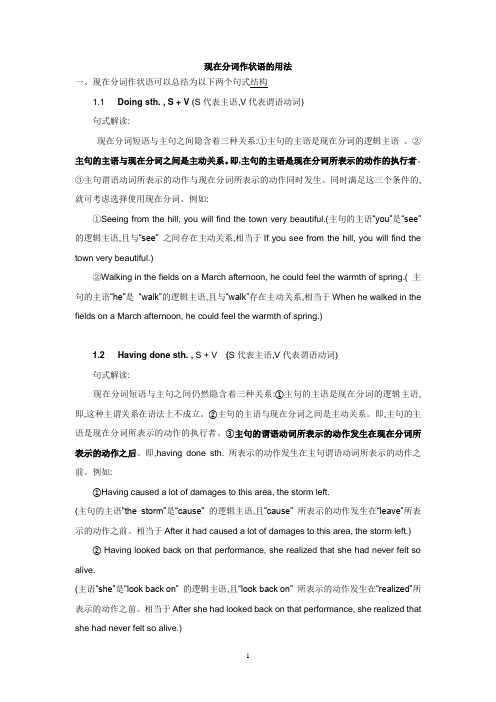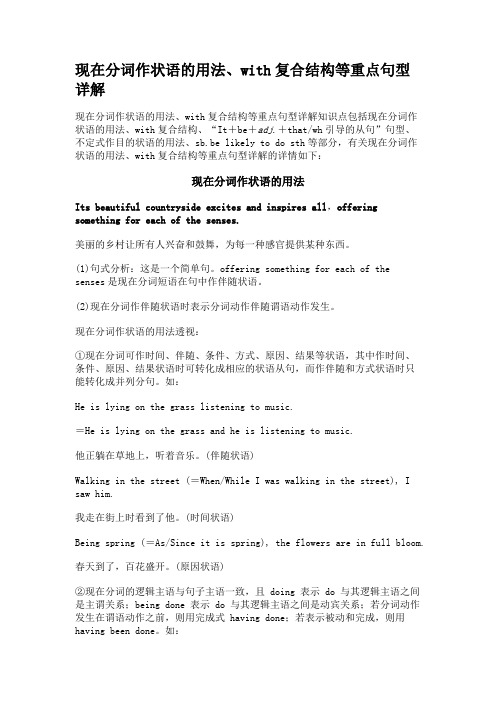现在分词短语作结果状语的用法
- 格式:doc
- 大小:21.50 KB
- 文档页数:1

不定式和现在分词作结果状语的区别
不定式和现在分词均可用结果状语,但两者用法有区别:
(1) 现在分词用作结果状语
通常表示一种自然的结果,即属预料之中的事。
如:
He died, leaving his wife with five children. 他死了,留下他妻子和五个儿子。
The child fell, striking his head against the door and cutting it. 那孩子跌倒了,头碰在门上磕破了。
(2) 不定式用作结果状语
主要表示没有预料到的情况或结果,即属预料之外的事。
该用法通常与副词only连用。
如:
He lifted a rock only to drop it on his own feet. 他搬起石头砸了自己的脚。
He hurried to the house only to find that it was empty. 他急忙赶到那所房子,却发现空无一人。
She got there only to be told that they had gone on holiday. 她到达那里,被告知他们度假去了。
注意:并非所有表示结果的不定式都含有这种“意外”的效果。
如:
What have I done to offend you. 我干什么惹你生气了?
The tea is too hot to drink. 茶太热,不能喝。

V-ing 作状语用法1.现在分词的一般式表示该动作在与谓语动作同时发生或在谓语动作之后发生,完成式则表示该动作发生在谓语动作之前,在句中只能作状语表示时间和原因。
如:Standing on top of the hill, you can see as far as the seaside. (分词动作与谓语动作同时发生)The fish can eat a person in two minutes, leaving only bones. (分词动作在谓语动作之后发生)Having finished his homework, the boy went out to play football. (分词动作在谓语动作之前发生)2.现在分词的主动式表示动作是由句子主语发出,而被动式表明主语承受该动作。
如:__________ (notice) by so many people, she felt nervous, ____________ (not know)what to say.Not having been washed in the correct way, the coat has faded.3.现在分词在句中作状语时可表示时间、原因、条件、伴随和结果等。
通常可以改为相应的从句或并列句。
如:Walking along the street, he met his old friend.=Not having received his reply, she decided to write a second letter.=Seeing from the top of the hill, you will find the city more beautiful.=All the students sat in the classroom, waiting for their new English teacher.=My parents went to the park yesterday, leaving me alone at home.=注意:当分词在句中作结果状语,其逻辑主语为前面整个句子时。

现在分词短语作状语现在分词短语作状语是英语中常见的一种短语结构,它通常用来修饰句子中的主句动词,表达时间、原因、条件、方式等意义。
下面是一些例子:1. Walking slowly, he enjoyed the beautiful scenery along the river.(慢慢地走着,他欣赏着河边美丽的风景。
)2. Being a doctor, she has to work long hours every day.(作为一名医生,她每天必须工作很长时间。
)3. Having finished his homework, he went out to play with his friends.(完成了作业后,他和朋友们出去玩了。
)4. Seeing the dark clouds, we decided to postpone our picnic. (看到乌云密布,我们决定推迟野餐计划。
)5. Hearing the news, she burst into tears.(听到消息后,她泪如雨下。
)6. Knowing little about computers, he asked for help from his friend.(对电脑知之甚少,他向朋友求助。
)7. Feeling tired after a long day's work, she went straight to bed. (一天辛苦工作后感到疲惫不堪,她直接上床睡觉了。
)8. Hoping to win the game, they practiced hard every day.(希望赢得比赛,他们每天都刻苦练习。
)以上是一些常见的现在分词短语作状语的例子,它们都能够起到修饰句子、表达含义的作用。
在使用时需要注意语境和语法结构,避免出现歧义或错误。

现在分词作状语的用法一、现在分词作状语可以总结为以下两个句式结构1.1 Doing sth. ,S + V (S代表主语,V代表谓语动词)句式解读:现在分词短语与主句之间隐含着三种关系:①主句的主语是现在分词的逻辑主语。
②主句的主语与现在分词之间是主动关系。
即,主句的主语是现在分词所表示的动作的执行者。
③主句谓语动词所表示的动作与现在分词所表示的动作同时发生。
同时满足这三个条件的,就可考虑选择使用现在分词。
例如:①Seeing from the hill, you will find the town very beautiful.(主句的主语“you”是“see”的逻辑主语,且与“see” 之间存在主动关系,相当于If you see from the hill, you will find the town very beautiful.)②Walking in the fields on a March afternoon, he could feel the warmth of spring.( 主句的主语“he”是“walk”的逻辑主语,且与“walk”存在主动关系,相当于When he walked in the fields on a March afternoon, he could feel the warmth of spring.)1.2 Having done sth. , S + V (S代表主语,V代表谓语动词)句式解读:现在分词短语与主句之间仍然隐含着三种关系:①主句的主语是现在分词的逻辑主语,即,这种主谓关系在语法上不成立。
②主句的主语与现在分词之间是主动关系。
即,主句的主语是现在分词所表示的动作的执行者。
③主句的谓语动词所表示的动作发生在现在分词所表示的动作之后。
即,having done sth. 所表示的动作发生在主句谓语动词所表示的动作之前。
例如:①Having caused a lot of damages to this area, the storm left.(主句的主语“the storm”是“cause” 的逻辑主语,且“cause” 所表示的动作发生在“leave”所表示的动作之前。

现在分词作状语的用法、with复合结构等重点句型详解现在分词作状语的用法、with复合结构等重点句型详解知识点包括现在分词作状语的用法、with复合结构、“It+be+adj.+that/wh引导的从句”句型、不定式作目的状语的用法、sb.be likely to do sth等部分,有关现在分词作状语的用法、with复合结构等重点句型详解的详情如下:现在分词作状语的用法Its beautiful countryside excites and inspires all,offering something for each of the senses.美丽的乡村让所有人兴奋和鼓舞,为每一种感官提供某种东西。
(1)句式分析:这是一个简单句。
offering something for each of thesenses是现在分词短语在句中作伴随状语。
(2)现在分词作伴随状语时表示分词动作伴随谓语动作发生。
现在分词作状语的用法透视:①现在分词可作时间、伴随、条件、方式、原因、结果等状语,其中作时间、条件、原因、结果状语时可转化成相应的状语从句,而作伴随和方式状语时只能转化成并列分句。
如:He is lying on the grass listening to music.=He is lying on the grass and he is listening to music.他正躺在草地上,听着音乐。
(伴随状语)Walking in the street (=When/While I was walking in the street), I saw him.我走在街上时看到了他。
(时间状语)Being spring (=As/Since it is spring), the flowers are in full bloom.春天到了,百花盛开。
(原因状语)②现在分词的逻辑主语与句子主语一致,且 doing 表示 do 与其逻辑主语之间是主谓关系;being done 表示 do 与其逻辑主语之间是动宾关系;若分词动作发生在谓语动作之前,则用完成式 having done;若表示被动和完成,则用having been done。

现在分词作状语的用法讲解现在分词是英语语法中的一种重要的句法成分,在句子中可以作状语。
状语是限制句子的重要成分,可以修饰谓语动词、主语、宾语或整个句子,用来表示动作或状态的方式、过程、时间、条件等。
因此,要掌握现在分词作状语的用法是英语句子结构掌握的重要环节。
一、现在分词作状语的构成在英语中,现在分词作状语是由动词的不定式形式(to do)加上ing组成的。
现在分词作状语既可以表示动作发生的正在进行,也可以表示动作发生的频率,强调动作的状语成分。
二、现在分词作状语的用法1.表示正在进行的动作现在分词作状语,既可以表示动作的发生,也可以表示动作的进行。
表示动作的发生时,现在分词常与表示时间的时间状语一起使用,如these days,today,now等;表示动作的进行,现在分词常与表示动作发生的伴随动作或情况,以及表示动作发生的时间状语一起使用,如while,when,before,after等。
例如:We are studying English while listening to the teacher.我们在听老师讲话的同时,正在学习英语。
2.表示动作发生的频率现在分词作状语,也可以用来表示动作发生的频率。
此时,现在分词一般与表示动作发生的频率的时间状语,如often,always,seldom,rarely,sometimes,occasionally,hardly,never等一起使用。
例如:He is always playing computer games.他总是玩电脑游戏。
三、现在分词作状语的特殊情况1.在分词作独立主格结构在句子中,现在分词与主语之间也可以组成独立结构,即现在分词作独立主格结构,表示一种客观存在的状态。
此时,现在分词作独立主格结构,可以表示谓语动词所描述的动作发生的情况,也可以表示谓语动词的客观存在的状态。
Seeing is believing.百闻不如一见。
现在分词作状语现在分词短语可以用作状语,修饰句子中由谓语表示的主要动作。
这个状语可以表示动作发生的时间、原因、结果、条件、或表示主要动作发生的伴随情况,通常相当于一个状语从句或并列分句。
一般说来,这种结构的逻辑主语就是句子的主语。
一、作时间状语 如果现在分词的动作和主谓语的动作同时发生,分词用一般式,有时其前可以加上连词while或when。
例如:①Hearing the news,they all jumped with joy.② Walking slowly across the grass,he pointed the gun at the lion and fired. ③One day,while walking along the sands towards his boat,Crusoe saw in the sand the mark of a man's foot. 如果现在分词的动作结束之后,谓语动词的动作才发生,现在分词应用完成式。
这时分词所表示的动作有一定的持续性。
例如: ① Having watered the flowers,he began to cut the grass. ② Having eaten his dinner,the boy rushed out. ③Hearing the footstep below(=When he heard the footstep below),he rose and went to the top of the stairs.④ Seeing a large cake flying through the air,the driver pulled up quickly.注:①分词动作一发生,谓语动作紧跟着发生,这时用现在分词的一般式作时间状语,其逻辑主语为句中的主语。
常用的动词,如:hear, see, arrive, return, get to, look, open, close, leave, turn around, walk等,表示一个极短暂动作。
高考英语语法应用讲解一、现在分词作状语在写作中的应用(一)现在分词做时间状语现在分词表示的动作和谓语动作同时发生或紧接着发生,就用一般式:Ving例句1:Hearing the good news, they all jumped with joy.听到这个好消息,他们都高兴得跳起来。
可以用时间状语从句替换:When they heard the good news, they all jumped with joy.例句2:Standing on the stage, a sense of tension welled up in my heart.站在舞台上,紧张感油然而生。
可以用时间状语从句替换:When I stood on the stage, a sense of tension welled up in my heart.仿写练习:看着这些照片,往日记忆涌上心头。
1.用现在分词作时间状语:_______________________________2.可以改为时间状语从句:_______________________________【答案】1.Seeing these photos, memories of those old days flooded into his mind2.When I saw these photos, memories of those old days flooded into his mind.在强调现在分词动作先于谓语动作时,用完成式:having doneeg:Having eaten her lunch, the girl rushed out.那女孩吃完了午饭就跑出去了.(先吃eat 后跑出rush out)Having thought about the present situation for a while, Roy decided to apologize to Jane .思考现状一会儿后,Roy 决定向Jane道歉。
分词作状语的用法分词作状语是英语语法中的一个重要部分,它可以使句子更加生动而有力。
本文将说明分词作状语的用法及相关注意事项。
一、分词作时间状语分词作时间状语可以表示动作发生的时间或时间先后顺序。
1. 过去分词作时间状语:Having finished his homework, he went out to play.过去分词短语作时间状语,表示主句发生的时间在过去分词的动作发生之后。
2. 现在分词作时间状语:Hearing the news, they were very excited.现在分词短语作时间状语,表示主句发生的时间在现在分词的动作发生之时。
3. 不定式短语作时间状语:To improve his English, he practices speaking every day.不定式短语作时间状语,表示主句发生的时间是为了达到不定式的目的。
二、分词作原因状语分词作原因状语可以表示动作发生的原因或原因结果关系。
1. 过去分词作原因状语:Being tired, she decided to go to bed early.过去分词短语作原因状语,表示主句发生的原因是过去分词的动作。
2. 现在分词作原因状语:Seeing the dark clouds, they decided to bring umbrellas.现在分词短语作原因状语,表示主句发生的原因是现在分词的动作。
3. 不定式短语作原因状语:To save money, he stopped eating out.不定式短语作原因状语,表示主句发生的原因是不定式的目的。
三、分词作条件状语分词作条件状语可以表示动作发生的条件或条件结果关系。
1. 过去分词作条件状语:Given the chance, he would travel around the world.过去分词短语作条件状语,表示主句发生的条件是过去分词的动作。
现在分词的用法1. 用作主语现在分词可以作为句子的主语,表示动作或状态。
这时,现在分词的形式通常为动词的现在分词形式加上ing。
例如:- Swimming is her favorite sport.(游泳是她最喜欢的运动。
)- Studying hard is important for academic success.(努力研究对于学术成功很重要。
)2. 用作定语现在分词可以用来修饰名词或代词,相当于一个形容词。
这时,现在分词的形式通常为动词的现在分词形式加上ing。
例如:- The running water sounded refreshing.(流动的水听起来很清新。
)- The crying baby needs attention.(哭泣的婴儿需要关注。
)3. 用作状语现在分词可以用来修饰动词、形容词或副词,表示附加的行为或状态。
现在分词作状语时,通常表示主动、进行或结果。
例如:- He left the room, slamming the door behind him.(他离开房间时,砰地关上了门。
)- The children played happily, laughing and shouting.(孩子们玩得很开心,笑着和喊着。
)4. 用作介词宾语现在分词可以作为介词的宾语,表示同一时间的行为。
在这种情况下,现在分词的形式通常为动词的现在分词形式加上ing。
例如:- She sat on the bench, reading a book.(她坐在长椅上读书。
)- They walked in the park, enjoying the sunshine.(他们在公园里散步,享受阳光。
)综上所述,现在分词在英语中具有多种用法。
通过灵活运用这些用法,能够丰富语言表达,使句子更加生动有力。
> 注意:以上内容是为了示范现在分词的用法,实际使用时需要根据具体语境和语法规则进行判断。
现在分词短语作结果状语的用法
【原句展示】认真阅读下列句子,观察划线部分在句中的用法。
1. ... up to 50% of the area’s population died from this epidemic making it one of the main causes of the fall of the Roman Empire. (P39)
……多达50%的人口死于那场瘟疫,使之成为罗马帝国衰落的主要原因之一。
2. Terri had fallen into a coma in 1990 when a heart attack robbed her brain of oxygen causing permanent harm. (P40)
1990年,特瑞陷入了昏迷状态,当时一次心脏病夺走了她大脑中的氧气,给她造成了永久性的伤害。
在以上两句中,现在分词短语作结果状语。
该短语可以理解为一个由which 引导的定语从句,引导词which指代前面提到的整个句子,如句1就可以改写为:... up to 50% of the area’s population died from this epidemic, which makes it one of the main causes of the fall of the Roman Empire.
现在分词短语在句中作结果状语时,通常位于句末,中间可以用逗号隔开,也可以不用。
有时为了加强语气,还可以在分词前加thus。
例如:
The new machines will work faster, thus reducing our cost.
新的机器将运转得更快,因此降低了我们的成本。
【小试】请用现在分词短语作结果状语这一用法翻译下列句子。
1. 1942年她丈夫死了,给她丢下了五个孩子。
2. 雪下了一个星期,造成了整个地区严重的交通混乱。
Key:
1. Her husband died in 1942, leaving her with five children.
2. The snow lasted a week, resulting in a serious traffic confusion in the whole area.。